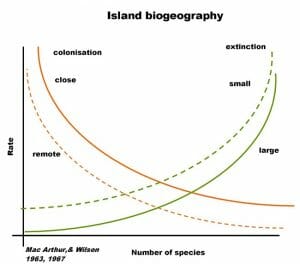Theory of Island Biogeography
Island biogeography (also called insular biogeography) provides some of the best evidence in support of natural selection and the theory of evolution. The term describes an ecosystem that is isolated by being surrounded by different ecosystems. For the purposes of this theory, an island is defined as more than just a piece of land surrounded by water. It includes mountain peaks, a lake surrounded by a desert, a patch of woodland or even a national park. The theory provides a model to explain the richness and uniqueness of species, both plants and animals, found in an isolated area.
The two events that determine how many species are found in an isolated ecosystem are immigration and extinction. Research as shown that how big the island is and how far it is from the mainland have a great influence on the number (richness) of species that are found there (see image below). Once species have established themselves on an island, the rate at which they will go extinct depends on the size of the island, with there being less likelihood of extinction on larger islands. This is called the species-area relationship. This relationship is not just observable, but it can also be predicted mathematically. By the same theory, the farther an island is from the mainland, the fewer species it tends to have. This is referred to as the species-distance relationship.

The image above shows how the size of an island and its distance from the mainland interact with immigration (colonization, the orange lines) and extinction events (green lines) to influence the richness of species.
Alfred Russel Wallace, the Father of Biogeography
In the mid-19th century, the British naturalist and explorer Alfred Russel Wallace traveled to the Amazon Basin and the Malay Archipelago (located between China and Australia) to build on the work of Charles Darwin and study how and why the flora and fauna were distributed. He paid particular attention to the distributions of butterflies and birds in relation to the presence and absence of natural geographic barriers like rivers, valleys and mountains. Wallace’s findings contributed significant knowledge to the field of biogeography, including his discovery of the sharp contrasting differences in the animals on either side of what is now the Wallace Line, named to acknowledge the importance of his work.
Island Biogeography Examples
Australia
Marsupials like the kangaroo and the wallaby are only found in Australia. If marsupials were found all over the world, then that would mean they did not come into existence by means of natural selection and the evolutionary process. Additional evidence for this evolutionary model is shown by the fact that about 75% of the plant and mammal species in Australia are found only on that continent. There are some exceptions, however, due to continental drift when animals were able to wander around large land masses before they separated.
The Galapagos and Cape Verde Islands
When he visited the Galapagos and Cape Verde Islands in 1835, Charles Darwin encountered species that are found nowhere else on Earth like the Galapagos Tortoise, the Flightless Cormorant, the Blue-footed Boobie and, of course, the famous Darwin’s Finches. But it’s not just the fact that these isolated environments gave rise to unique species—each island also had its own unique species. In addition, Darwin noted at the time that none of the species from these islands were found in similar climates anywhere in the world. Darwin wondered why there were distinct species on each of the islands when the climates are virtually identical, and why there appeared to be closely related species on the nearest mainland continent. These observations led to his hypothesis (at the time) that the islands had broken off separately from the main continent sometime in the distant past, resulting in two identical populations that evolved separately over time.
References
- Adaptive Radiation. (2017, June 29). In New World Encyclopedia. Retrieved from http://www.newworldencyclopedia.org/entry/Adaptive_radiation
- Biogeography. (n.d.). In Wikipedia. Retrieved June 29, 2017 from https://en.wikipedia.org/wiki/Biogeography
- Insular biogeography. (n.d.). In Wikipedia. Retrieved June 29, 2017 from https://en.wikipedia.org/wiki/Insular_biogeography
